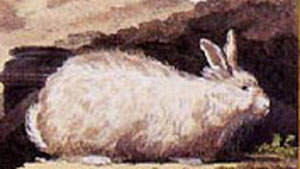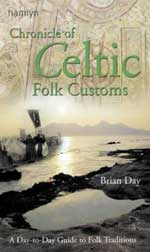| |

Traditions, folklore, history and more. If it's Irish, it's here. Or will be!
"People will not look forward to posterity who never look backward to their ancestors."
-Edmund Burke




Quotes
Library: Books, Movies, Music
Prints & Photos
Poetry
Jokes


Shops Ireland
Bunús na Gaeilge
(Basic Irish)
Circle of Prayer
Blessings
Did You Know?
Himself/Herself
Write to Us
Readers Write..
Links/Link to Us
Advertise with us
Awards & Testimonials
Submissions Guide


|
|
|
April Fool's Day
by Bridget Haggerty
 'Pinch, punch, first day of the month, white rabbit.' This was the phrase my mother taught us to say on the first day of every month - not just April. I have no idea what it means, except that it gave my brothers and I a grand excuse to get into some good-natured scuffles. 'Pinch, punch, first day of the month, white rabbit.' This was the phrase my mother taught us to say on the first day of every month - not just April. I have no idea what it means, except that it gave my brothers and I a grand excuse to get into some good-natured scuffles.
According to my mother, it was lucky if you saw a white rabbit and, to ensure good fortune, she always wore the rabbit's foot she'd brought from Ireland.
As with most children, we loved April Fool's Day. Classic pranks were trotted out every year - your shoelaces are undone, your slip is showing, your fly's open, or there's dirt on your shirt. We also tried pinning notes on each other's backs which would say things like "kick me" or "kiss me." Even my dad was known to get in on the antics by sending one of us on a wild goose chase. We'd be dispatched to a neighbor on some unlikely errand, such as 'fetching a whistle to bring down the wind.'
As I write this, I remember the early years of living in the city we now call home. A local rock station always broadcast their "Annual Fool's Day Parade" - a one-hour show devoted to describing an imaginary procession of unlikely participants who were led by Our Lady of Perpetual Motion Marching Band. The announcers made it all sound so realistic, many listeners were duped into believing that there was a real event going on downtown!
So how did all of this silliness come about? Believe it or not, research indicates that we've been playing tricks on each other for nearly two thousand years! Hilaria was a spring festival celebrated by the Romans, as was another day of celebration in honor of Lod, the Celtic God of humor. Occurring as they did at the end of what was usually a hard winter, the people took great delight in anticipating spring with fun, frivolity and foolishness - usually at the expense of neighbors and friends.
Up until the 16th century, the beginning of the New Year was celebrated on April 1st after a week of festivities which began around March 25th. When Pope Gregory introduced a new Christian calendar in 1582, New Year's Day shifted to January 1st. Many folks either didn't hear the news, or didn't believe it, and continued to celebrate New Years when they always had. It was most likely then that the term April Fool became a part of our language and the custom of sending people on false errands or giving them false news became widespread. In Scotland, April Fool's Day is called "Taily Day" which is derived from the name for a pig's tail. In the old day's, embarrassing items such as a pig's tail were pinned on an unsuspecting victim's back. Even to this day, tricks are confined to backs or bottoms.
Over in Ireland, a common practical joke was to send someone to deliver a note that read "send the fool further." In many places, these 'fool's errands' would be accompanied by a verse for the recipient which said "don't you laugh, and don't you smile, send the gowk another mile." A gowk is a Celtic word for cuckoo and was commonly applied to a gullible or naive person.
As with most Celtic customs, timing was critically important. Tricks could be played only until noon. The exception was on Orkney where one had to wait until after noon to perpetrate a prank.
Today, practical jokes are still being played all over the world - and some of them can be very elaborate. Just a few years ago, the very staid and conservative BBC televised a documentary about spaghetti farmers in Italy; they even showed them harvesting the crop from the spaghetti trees! Wish I'd seen that one.
So there you have it - a brief look at how the Celts celebrated April Fool's. Which leads me to this warning - watch your back, and be especially wary of anyone who asks you to go fetch "memory powder", pigeon's milk, or a stone to make the pigs do the St. Vitus Dance." Sound implausible? Anything is possible!
One of our subscribers, Bill Smith of North Carolina, read our article and was reminded of his days in the US Navy. We thought you might enjoy these yarns as much as we did:
For 20 years, two months and two days (but who was counting?) I was enlisted in the US Navy. Any milestone celebration (Crossing the Equator, the Arctic Circle, the International Dateline - of which I did all three in my 20 years) was rife with such pranks. I remember a shipmate who was sent with a supply chit to get three feet of fallopian tubing. The Storekeeper, of course, had none at hand and sent the hapless lad to see the Supply Officer.
The Supply Officer said there was very little on board and that it was in the custody of the Medical Officer. The seaman was then sent to Sick Bay with a second chit to draw from Medical Supply the requested material, and Dr. Janet Sussman was the third in the Medical Department to receive the request, hand delivered, of course, by the naive one. Janet didn't bat an eye, and told him she was using the last few inches of the precious tubing presently - and then very slowly and clearly explained to the increasingly embarrassed youth just what fallopian tubes were.
At one time early in my submarine career (16 out of my 20 years were in the submarine community), I was sent to find one pound of Relative Bearing Grease. Having been schooled in navigation, I knew what relative and true bearing was (angular displacement from the bow of the ship or from North, respectively), I realized immediately the nature of the quest - but I played along with it just for fun.
Within 30 minutes of the errand, I was called to stand watch on the Electronic Counter Measures stack - to listen for radar/radio emissions when at periscope depth. As I sat there scanning the huge range of frequencies, I grew bored, looked at the overhead and saw - Relative Bearing Box - a connection box for wiring for the radar and sonar systems. At my next opportunity, I reported to the one who sent me on the errand that I had found the grease and placed it in the Relative Bearing Box for his retrieval as needed. I found it very amusing that he didn't think there was any such thing as a Relative Bearing Box and accused me of trying to fool him. I always say the best lie is the truth!
Bill Smith
Resources:
 Content: Chronicle of Celtic Folk Customs Content: Chronicle of Celtic Folk Customs
by Brian Day.
Image: Angora Rabbit from All Posters
|
|
Fri, Sep 27, 2024
 The Galway Hooker The Galway Hooker
This unique vessel, with its distinctive curved lines and bright red sails, originated in the village of Claddagh. During the 19th century, hookers supported a significant fishing industry and also carried goods, livestock and fuel. Seán Rainey is remembered for building the last of the original boats, the Truelight, for Martin Oliver who was to become the last king of the Claddagh; as king, he was entitled to white sails on his boat. Since the mid seventies, many of the old sailing craft which were on the verge of extinction have been lovingly restored and new ones have been built. During the summer months they can be seen at festivals such a Cruinniú na mBád - the Gathering of the Boats - in Kinvara.
Click for More Culture Corner.
|
|




 The Galway Hooker
The Galway Hooker